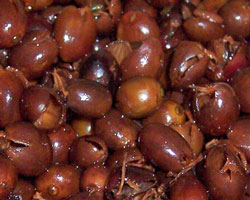 Today, I'd like to introduce you to cascara.
Today, I'd like to introduce you to cascara.
It's not a kind of make-up.
It's not a sequence of waterfalls.
It's a byproduct of the coffee producing process, which most people in these shores haven't heard of. Yet in the coffee producing regions it is turned into a drink in its own right.
Meet: Cascara
The fruit of the coffee tree is called a cherry. Think of the cherries you buy at the market. Slightly larger. Usually with two stones inside, not one. That is what the coffee cherry is like. (Sometimes, coffee trees produce cherries with only a single stone, in which case the stone is round rather than hemispherical. That is what makes a "peaberry" bean).
The bit we drink when we have a cup of coffee are the stones. They are washed and dried, or just dried, or prepared in some other way. The result is a small hard green bean, with a low moisture content, that is exported, roasted and ground.
But what happens to the fruit of the cherry around the outside. Usually, nothing. This is what can be dried to become cascara. It can then be brewed into a delicious beverage. All you need is a teapot, or something similar. Warm it. Use water slightly off the boil. (You know, don't you, to use bubbling boiling water to make tea, but water at 90-95 C to make coffee? You want the same off-boiling water that you use for coffee.) You may not be brewing a full litre, but the ratio you want is 24 grams for every litre. Steep for 4 minutes. Strain and drink - probably black, but it takes milk too. It's naturally quite sweet, so you may not need sugar!
Be aware - it's very caffeinated!
You may wish to find out more: Steve Leighton of Has Bean Coffee has produced a Brew Guide to talk you through how to make a tasty cup.
Oh, but you'll need some cascara if you want to make it into a drink. Steve's got some of that too - at time or writing. But coffee is a seasonal crop, so you may have to search the net a bit if you're reading this some time after I wrote it. Enjoy!
(Picture credit: Christian Frausto Bernal)
Recent comments